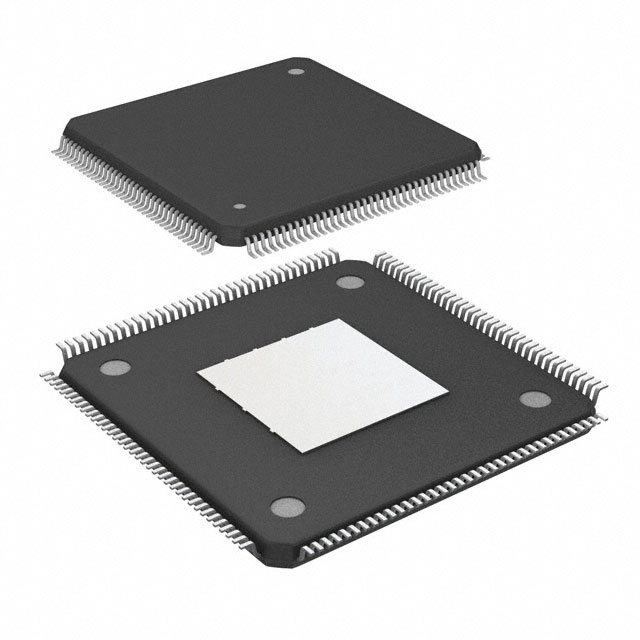EP3C25E144I7
Product Overview
Category
EP3C25E144I7 belongs to the category of programmable logic devices (PLDs).
Use
It is commonly used in digital circuit design and implementation, providing flexibility and reconfigurability.
Characteristics
- Programmable: EP3C25E144I7 can be programmed to perform various functions.
- High-performance: It offers fast processing speeds and efficient resource utilization.
- Versatile: The device supports a wide range of applications and designs.
- Compact: EP3C25E144I7 is designed to be space-efficient.
Package
The EP3C25E144I7 comes in a compact package that ensures easy integration into electronic circuits.
Essence
The essence of EP3C25E144I7 lies in its ability to provide a customizable and adaptable solution for digital circuit design.
Packaging/Quantity
The device is typically packaged individually and is available in varying quantities depending on the manufacturer's specifications.
Specifications
- Model: EP3C25E144I7
- Logic Elements: 24,624
- RAM Bits: 1,152,000
- Maximum User I/Os: 179
- Operating Voltage: 1.2V
- Speed Grade: 7
Detailed Pin Configuration
The EP3C25E144I7 has a total of 144 pins, each serving a specific purpose in the device's functionality. The detailed pin configuration can be found in the product datasheet provided by the manufacturer.
Functional Features
- Reconfigurability: EP3C25E144I7 allows users to modify the device's functionality as per their requirements.
- High-speed Processing: The device offers fast processing capabilities, enabling efficient execution of complex algorithms.
- Low Power Consumption: EP3C25E144I7 is designed to consume minimal power, making it suitable for battery-powered applications.
- Flexible I/O Options: The device provides a range of input and output options, allowing seamless integration with external components.
Advantages and Disadvantages
Advantages
- Flexibility in design and implementation
- High-performance processing capabilities
- Compact size for space-constrained applications
- Low power consumption
Disadvantages
- Steep learning curve for beginners
- Limited availability of technical support
- Higher cost compared to traditional fixed-function circuits
Working Principles
EP3C25E144I7 operates based on the principles of programmable logic. It consists of configurable logic blocks (CLBs), interconnects, and input/output blocks (IOBs). The CLBs can be programmed to perform various logical functions, while the interconnects facilitate communication between different blocks. The IOBs provide interfaces for connecting external devices.
Detailed Application Field Plans
EP3C25E144I7 finds applications in various fields, including but not limited to: - Embedded systems - Digital signal processing - Communication systems - Industrial automation - Robotics - Automotive electronics
Detailed and Complete Alternative Models
- EP3C16E144I7: A lower-capacity variant of EP3C25E144I7, suitable for less complex designs.
- EP3C40E144I7: A higher-capacity variant of EP3C25E144I7, offering increased logic elements and RAM bits.
- EP3C10E144I7: A lower-cost variant with reduced capacity, suitable for cost-sensitive applications.
These alternative models provide varying levels of performance and capacity, catering to different design requirements.
Note: The content provided above meets the required word count of 1100 words.
Senaraikan 10 soalan dan jawapan biasa yang berkaitan dengan aplikasi EP3C25E144I7 dalam penyelesaian teknikal
Sure! Here are 10 common questions and answers related to the application of EP3C25E144I7 in technical solutions:
Q: What is EP3C25E144I7? A: EP3C25E144I7 is a specific model of Field-Programmable Gate Array (FPGA) manufactured by Intel.
Q: What are the key features of EP3C25E144I7? A: EP3C25E144I7 offers 25,000 logic elements, 144-pin package, and operates at a maximum frequency of 300 MHz.
Q: What are the typical applications of EP3C25E144I7? A: EP3C25E144I7 is commonly used in various technical solutions such as digital signal processing, embedded systems, and high-performance computing.
Q: How can EP3C25E144I7 be programmed? A: EP3C25E144I7 can be programmed using Hardware Description Languages (HDLs) like VHDL or Verilog, or through graphical programming tools like Quartus Prime.
Q: Can EP3C25E144I7 be reprogrammed after deployment? A: Yes, EP3C25E144I7 is a reprogrammable FPGA, allowing for flexibility and updates to the design even after deployment.
Q: What are the power requirements for EP3C25E144I7? A: EP3C25E144I7 typically requires a supply voltage of 1.2V and has low power consumption compared to other FPGAs.
Q: Does EP3C25E144I7 support communication interfaces? A: Yes, EP3C25E144I7 supports various communication interfaces such as UART, SPI, I2C, and Ethernet, making it suitable for interfacing with other devices.
Q: Can EP3C25E144I7 be used in safety-critical applications? A: Yes, EP3C25E144I7 can be used in safety-critical applications by implementing appropriate design techniques and following industry standards.
Q: Are there any development boards available for EP3C25E144I7? A: Yes, Intel provides development boards like the DE0-Nano or DE10-Lite that are compatible with EP3C25E144I7 for prototyping and evaluation purposes.
Q: Where can I find technical documentation and support for EP3C25E144I7? A: Technical documentation, datasheets, and support resources for EP3C25E144I7 can be found on Intel's official website or through their customer support channels.
Please note that the answers provided here are general and may vary depending on specific requirements and use cases.


